198 years ago today, Frederic Edwin Church, one of the foremost painters in the American landscape movement known as the Hudson River School, was born. His absolutely stunning depictions of North and South American wilderness put an emphasis on realistic detail, dramatic light, and panoramic views. In his pomp, Church was the most famous painter in New York City, and a wonderful selection of his works can be seen today at the National Gallery in Washington D.C. SEE some and read more about his life… (1826)
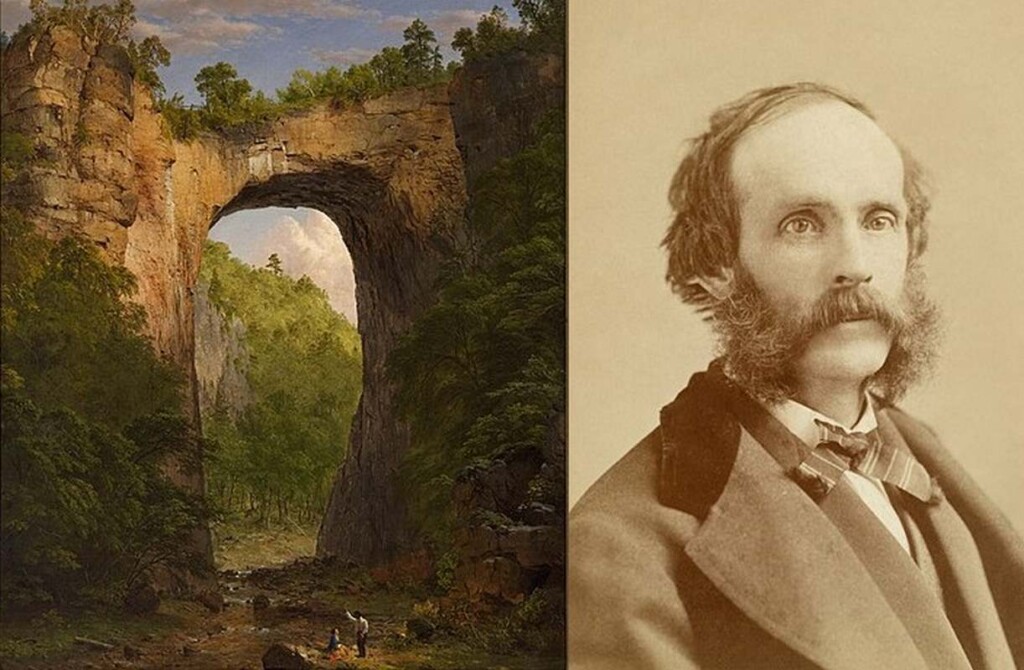
In 1844, at age 18, Church became the pupil of landscape artist Thomas Cole, the founder of the Hudson River School which would produce such names as Albert Bierstadt, Robert Walter Weir, and Thomas Moran. Cole wrote that Church had “the finest eye for drawing in the world,” and took him to see all manner of sights of iconic Mid-Atlantic scenery.

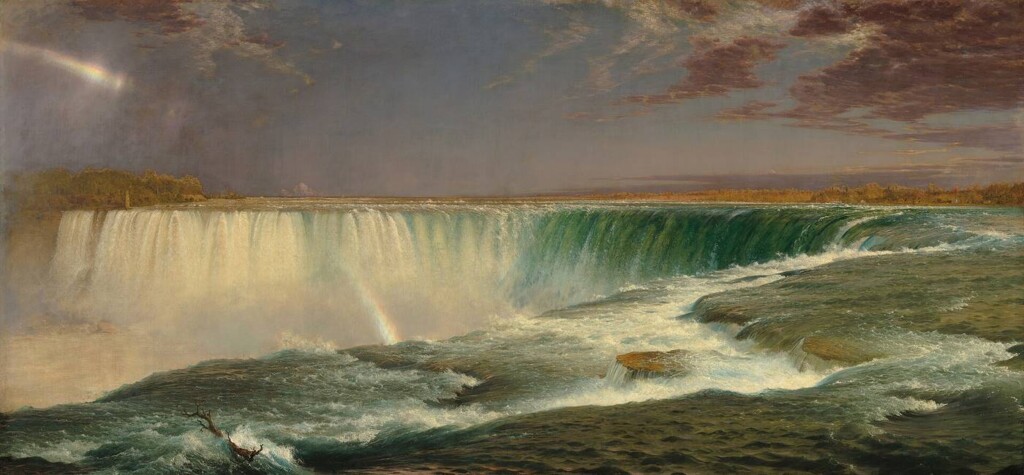
Church quickly earned a reputation as a traveler-artist, with early domestic painting and sketching trips to the White Mountains, western Massachusetts, the Catskills, Hartford, Conn, Niagara, Virginia, Kentucky, and Maine.
He made two trips to South America in 1853 and 1857 and stayed predominantly in Quito, visiting the volcanoes and cities of modern-day Colombia and Ecuador, and crossing the isthmus of Panama.
Another enormous trip in the 1860s saw him visit the Holy Land, as well as Egypt, Istanbul, parts of Greece and the Mediterranean, and eventually end his trip in Rome.
Church had been enormously successful as an artist. In his last decades, illness limited Church’s ability to paint. By 1876, Church was stricken with rheumatoid arthritis, making painting difficult. He eventually painted with his left hand and continued to produce works, although at a much slower pace. He still taught painting as Cole had before him. When he died it was rumored his fortune was worth half a million dollars.
MORE Good News on This Day:
- The Anglo-Dutch Slave Trade Treaty was signed by the Netherlands and Britain to outlaw slave trading and allow both nations to search vessels of the other suspected of carrying slaves, detain, and prosecute crew members found guilty. (1818)
- The U.S. state of Michigan ended the death penalty (1846)
- The National Association, the first professional baseball league, opened its first season in Fort Wayne, Indiana (1871)
- Ernest Hemingway was awarded the Pulitzer Prize for The Old Man and the Sea (1953)
- Margaret Thatcher became the first female Prime Minister of the United Kingdom (1979)
- Latvia proclaimed the renewal of its independence, following the Soviet occupation (1990)
- Today is International Firefighters Day, first proclaimed in Australia, but now observed worldwide (1999)
- The Milwaukee Art Museum outdoor addition, the first Santiago Calatrava-designed structure in the United States, opened to the public along the shoreline of Lake Michigan (2001)
- The power company, American Electric Power Ohio, began offering $1 million in grants to lower-income homeowners having trouble paying soaring energy bills (2009)
On this day 156 years ago, the world’s largest book was completed in the form of the entire Buddhist canon copied onto 730 marble tablets using chisels and gold ink. The monumental work saw a stonemason chisel out around 16 lines per day in the Burmese script, with each tablet capable of hosting 80 lines on each side. Each stone tablet has its own roof and precious gem on top, and sits in a small cave-like structure called a kyauksa gu. Called the Tripiṭaka tablets at Kuthodaw Pagoda, they were placed on the UNESCO Memory of the World Register.

The work was commissioned by King Mindon as part of his transformation of Mandalay into a royal capital. One of the most revered figures in Burmese history, Mindon wanted to leave a great work of merit for posterity meant to last five millennia after the Gautama Buddha who lived around 500 BC.
The marble was quarried from Sagyin Hill 32 miles (51 km) north of Mandalay, and transported by river to the city. Work began on October 14th, 1860 in a large shed near Mandalay Palace. The text had been meticulously edited by tiers of senior monks and lay officials consulting the Theravada Buddhist manuscripts at the royal library where they were made of palm leaves. (1868)
102 years ago today, “The Shark Lady,” Eugenie Clark was born. A seminal figure in American conservation, her barrier-breaking research into sharks dispelled myths about them being ferocious and unintelligent monsters, and is probably the most famous female American marine biologist, authoring two books, Lady with a Spear (1953) and The Lady and the Sharks (1969), as well as over 175 scientific articles.
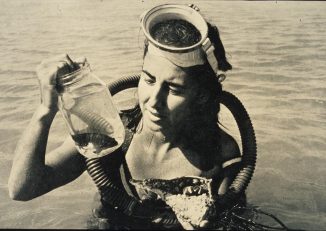
The Shark Lady was an avid supporter of marine conservation and many of her popular publications and public appearances focused on an effort to prevent the killing of sharks and to encourage the preservation of marine environments. She was the first person to train sharks to press targets, as well as the first scientist to develop “test tube” babies in female fish.
She also discovered that a fish called the Moses sole produces a natural shark repellent, which has since been employed by researchers aiming to prevent harmful interactions between sharks and humans. Clark’s observation of numerous “sleeping” sharks during her research dives helped to prove sharks do not need to move in order to breathe. Over her decades of research, Clark conducted over 70 submersible dives and led more than 200 field research expeditions around the world. She worked on 24 television specials and helped create the first IMAX film.
She was also somewhat of a shark on the home front, as she was married five times, one of which didn’t even last a year. Several species of fish have been named in her honor: Callogobius clarki Sticharium clarkae, Enneapterygius clarkae, Atrobucca geniae, and Squalus clarkae, also known as Genie’s dogfish. (1922)
63 years ago today, 13 volunteer activists, called Freedom Riders, began their bus trip through the deep south to protest lingering segregation on public transportation and in restaurants in the US, even though five years earlier discrimination against blacks on buses had been declared unconstitutional.
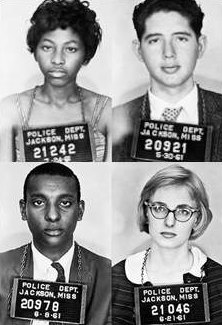 The original group — 7 Blacks and 6 Whites — which included the late Congressman John Lewis, grew to as many as 1,000 riders, from all walks of life, dedicated to non-violence and passive resistance. During their terror-filled journey, one bus was fire-bombed and some riders were beaten to unconsciousness by angry white mobs with iron pipes.
The original group — 7 Blacks and 6 Whites — which included the late Congressman John Lewis, grew to as many as 1,000 riders, from all walks of life, dedicated to non-violence and passive resistance. During their terror-filled journey, one bus was fire-bombed and some riders were beaten to unconsciousness by angry white mobs with iron pipes.
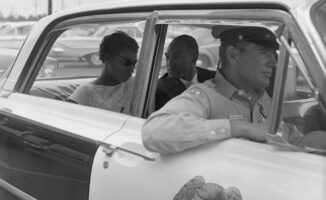
The ride ended on May 25 in Jackson, Mississippi, when the activists were arrested—and Lewis spent 37 days in jails and a state penitentiary.
The Freedom Riders focused the world’s attention on the racial discrimination suffered by African-Americans and it helped to bring about positive change, with President Kennedy and Attorney General Robert Kennedy moving to try to protect the riders and change the accepted norms of an interracial society. WATCH a clip from a PBS documentary… (1961)
Happy 53rd Birthday to Will Arnett, the Canadian-American comedic actor and producer best known for his role in the TV series Arrested Development, for which he received an Emmy nomination for Outstanding Supporting Actor in a Comedy Series. He’s also known for his role in the Teenage Mutant Ninja Turtles films, and his prolific voice acting with a deep, baritone in animated films like Ice Age, Ratatouille, Monsters vs. Aliens, and Despicable Me. His 9-show run on 30 Rock playing Devon Banks earned him four Emmys for Outstanding Guest Actor in a Comedy Series.

Last year, during the COVID-19 pandemic, he rejoined LEGO to resurrect his Batman character from the Lego Movie franchise to make a public service announcement with Ralph Fiennes that discusses kids’ fears, and washing your hands. WATCH the LEGO Batman safety message… (1970)
LEGO Batman has an important message for all you Batfans on how you too can be a super hero! 🌟
— LEGO (@LEGO_Group) May 2, 2020
Thanks @arnettwill Ralph Fiennes and @pistudios for your support 🤗 #ConnectedTogether @DCBatman pic.twitter.com/iSOW94c2n7
And, on this day in 1944, George Cukor’s film Gaslight was released. The mystery-thriller was nominated for seven Academy Awards, including Best Picture, Best Actor, and Best Screenplay, but it was Ingrid Bergman’s portrayal of a young wife being driven mad by her thieving, murdering husband that shone brightest, winning her three awards including the Golden Globe and Oscar for Best Actress.
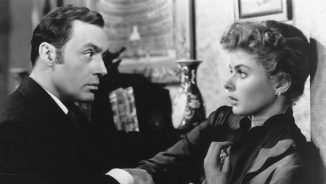 Charles Boyer was nominated for his leading role, and also notable was Angela Lansbury, nominated for Supporting Actress in her screen debut, playing the maid at age 18. The title of this fictional work, based on Patrick Hamilton’s 1938 play, Gas Light, actually became a psychological term (gaslighting), which describes the form of insidious psychological abuse in which the victim is gradually manipulated into doubting their own sanity.
Charles Boyer was nominated for his leading role, and also notable was Angela Lansbury, nominated for Supporting Actress in her screen debut, playing the maid at age 18. The title of this fictional work, based on Patrick Hamilton’s 1938 play, Gas Light, actually became a psychological term (gaslighting), which describes the form of insidious psychological abuse in which the victim is gradually manipulated into doubting their own sanity.
And, on this day in 1916, Jane Jacobs was born, a secretary from Greenwich Village who, angered by a scheme to erect a Manhattan Expressway through nearby SoHo and Little Italy, ended up changing urban planning forever.
Even though Jacobs had no formal training or college degree, the activist’s influential 1961 book, The Death and Life of Great American Cities, turned urban planning upside down. She argued that cities were living organisms that should be fun to live in, and criticized developments or freeways that isolated communities from the activity around it. Her clarion call caused cities like Baltimore to embrace mixed-use development, which transformed its Inner Harbor from urban decay into a major tourist attraction.
Jacobs believed her philosophy is what keeps cities safe, and coined the term, “eyes on the street”. She moved to Toronto in 1968 where she continued her work and also influenced Vancouver, BC’s urban planning for which she has been called “the mother of Vancouverism”, referring to that city’s use of her “density done well” philosophy. She passed away in 2006. WATCH a short bio…
SHARE the Milestones, Memories, and Music…




















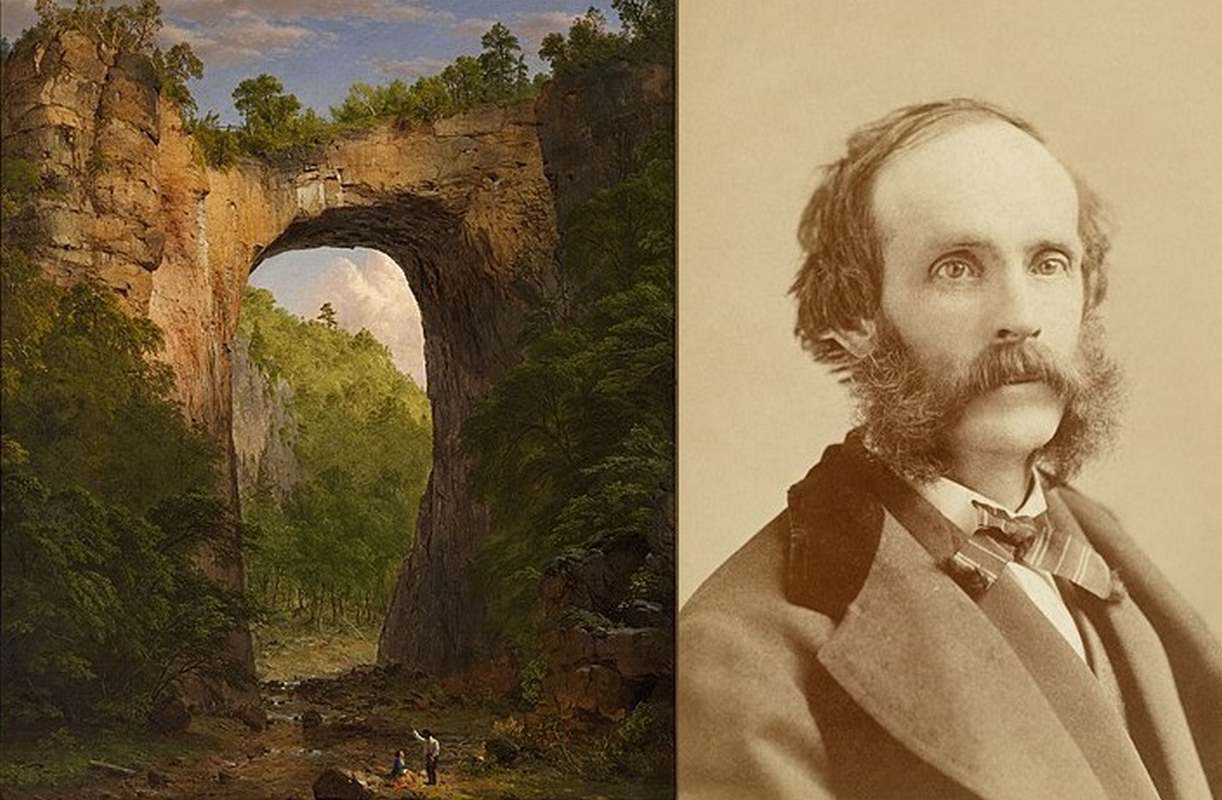
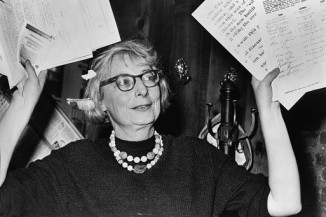
[…] post Good News in History, May 4 appeared first on Good News […]